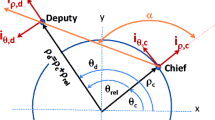Abstract
Geosynchronous Equatorial Orbit (GEO) is critical to Earth communications, weather monitoring, and national defense. Orbit estimation of GEO objects is difficult due to physical constraints placed on ground-based tracking devices such as weather, object range, lighting conditions and tracking frequency restrictions. These constraints are commonly mitigated through the use of two-way signaling devices for cooperative GEO satellites. However, determining the position and velocity of uncooperative GEO satellites and/or objects is more challenging. The objective of this paper is to develop an efficient tool to quantify the increased orbit determination accuracy of objects in the GEO catalog when the Air Force Space Command Space Surveillance Network (AFSPC SSN) is augmented with space-based angles-only measurements from a sensor in a unique near-GEO orbit. To accomplish this, a linear covariance tool is developed and validated by Monte Carlo analysis over a range of problem parameters. It is shown that linear covariance analysis is an efficient approach in determining the covariance of the position and velocity estimation errors of an uncooperative GEO object. Additionally, the linear covariance tool is used to perform error budget analysis.







Similar content being viewed by others
References
Vallado, D., Lowe, J., Anderson, J.: Benefits of hosted payload architectures for improved GEO SSA. In: Advanced Maui Optical and Space Surveillance Technologies Conference (2011)
Lowe, J., Vallado, D., Hall, B.: Technical analysis of commercially hosted optical payloads for enhanced SSA. In: Advanced Maui Optical and Space Surveillance Technologies Conference (2010)
Byrne, R., Griesmeyer, M., Schmidt, R., Shaddix, J., Bodette, D.: Benefits of a geosynchronous orbit (GEO) observation point for orbit determination, Tech. Rep. DTIC Document (2011)
Stokes, G., von Braun, C., Sridharan, R., Sharma, J.: The space-based visible program. Lincoln Lab. J. 11(2), 205–238 (1998)
Sharma, J., Stokes, G.H., von Braun, C., Zollinger, G., Wiseman, A.J.: Toward operational space-based space surveillance. Lincoln Lab. J. 13(2), 309–334 (2002)
Space Based Space Surveillance: http://www.afspc.af.mil/About-Us/Fact-Sheets/Article/249017/space-based-space-surveillance-sbss/. (2017). Accessed 10 May 2017
Bhaskaran, S., Desai, S., Dumont, P., Kennedy, B., Null, G., Owen, W., Riedel, J., Synnott, S., Werner, R.: Orbit determination performance evaluation of the Deep Space 1 autonomous navigation system. AIAA/AAS Space Flight Mechanics Meeting, Monterey, (1998)
Maybeck, P.S.: Stochastic models, estimation, and control, vol. 1. Academic Press (1982)
Christensen, R.S., Geller, D.: Linear Covariance techniques for closed-loop guidance navigation and control system design and analysis. J. Aerospace Eng. 228(1), 44–65 (2014)
Sharma, J.: Space-based visible space surveillance performance. J. Guid. Contr. Dyn. 23(1), 153–158 (2000)
Faccenda, W.J., Ferris, D., Williams, C.M., Brisnehan, D.: Deep Stare technical advancements and status. In: AMOS 2003 Technical Conference Proceedings (Advanced Maui Optical and Space Surveillance Technologies Conference), Maui Economic Development Board, Inc. Maui, HI (2003)
von Braun, C., Sharma, J., Gaposchkin, E.M.: Space-based visible metric accuracy. J. Guid. Contr. Dyn. 23(1), 175–181 (2000)
Curtis, H.D.: Orbital mechanics for engineering students. 2nd edn. Butterworth-Heinemann (2013)
Montenbruck, O., Gill, E.: Satellite Orbits. Models, Methods and Applications. Springer, Heidelberg (2000)
Vallado, D.A.: Fundamentals of Astrodynamics and Applications. 4th edn. Microcosm Press (2013)
Roithmayr, C.M.: Contributions of spherical harmonics to magnetic and gravitational fields. Tech. Rep. NASA/TM-2004-213007, L-18358, NASA Langley Research Center, Hampton, VA (2004)
Mueller, A.: A Fast recursive algorithm for calculating the forces due to the geopotential (Program: GEOPOT). Tech. Rep. JSC Internal Note 75-FM-42 (JSC-09731), NASA (1975)
Lear, W.M.: Kalman filtering techniques. Tech. Rep. JSC-20688, NASA Johnson Space Center, Houston, Texas (1985)
Andrews, S.E. (ed.): Proceedings of the 2000 Space Control Conference: Tech. Rep. STK-255, Massachusetts Institute of Technology Lexington Lincoln Lab (2000)
Schildknecht, T., Früh, C., Herzog, A., Hinze, J., Vananti, A.: AIUB efforts to survey, track, and characterize small-size objects at high altitudes. In: Proceedings of 2010 AMOS Technical Conference, pp. 14–17 (2010)
CubeSat design specification rev. 13: Tech. Rep. Cal Poly San Luis Obispo (2014)
Kreyszig, E.: Advanced engineering mathematics. 8th edn. John Wiley & Sons (1999)
Chapel, J., Stancliffe, D., Bevacqua, T., Winkler, S., Clapp, B., Rood, T., Gaylor, D., Freesland, D., Krimchansky, A.: Guidance, navigation, and control performance for the GOES-R spacecraft, Tech. Rep. GSFC-E-DAA-TN19917, NASA Goddard Space Flight Center; Greenbelt, MD (2014)
Abbot, R.I., Gaposchkin, E.M., Braun, C.V.: Midcourse Space Experiment Precision Ephemeris. J. Guid. Contr. Dyn. 23(1), 186–190 (2000)
Swedish Space Corporation Universal Space Network: http://www.sscspace.com/Products-Services/satellitemanagementservices/ground-network-prioranet-1. (2017). Accessed 10 March 2017
Author information
Authors and Affiliations
Corresponding author
Rights and permissions
About this article
Cite this article
Andrews, B.A., Geller, D.K. Analysis of Angles-Only Hybrid Space-Based/Ground-Based Approach for Geosynchronous Orbit Catalog Maintenance. J Astronaut Sci 69, 473–510 (2022). https://doi.org/10.1007/s40295-022-00313-3
Accepted:
Published:
Issue Date:
DOI: https://doi.org/10.1007/s40295-022-00313-3




